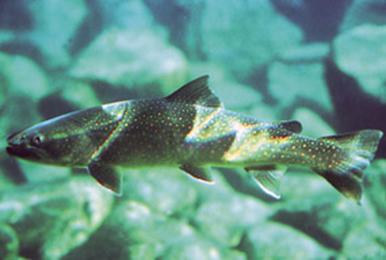Bull trout are a char of the Salmonidae family (salmon and trout) that are native to the Pacific Northwest. They inhabit cold clear waters of the mountains and coastal rivers in the Yukon, British Columbia, Washington, Oregon, and Idaho (not coastal here!). The species used to occur in northern California but is no longer found there. It is listed as a threatened species under the Federal Endangered Species Act. Habit loss, siltation of streams from roads and logging, and other water-related development is to blame for their decline. Chars have dark bodies with light spots while salmon have light-colored bodies with dark spots.
Char also have smaller scales. Salvelinus – from the German “sabling” – little salmon and confluentus from the Latin “connected”, possibly referring to their movement up and down watersheds? Bull trout are quite a pretty fish, with a dark background with yellow, orange, or salmon-colored spots on the back. Unlike an introduced char – the brook trout – bull trout do not have spots on their dorsal fin. Bull trout have distinctive white leading edges on their fins and a noticeably large head and mouth, giving them their name. A fish taken in the Tieton River of Washington weighed over 22 lbs. The more usual range for this fish is 12 – 20 inches and 4 lbs or so. The largest specimen recorded was just over 32 lbs. Bull trout display a wide range of spawning (occurring in the fall) behavior including:
Anadromous: major growth occurs in saltwater but spawning and rearing occur in coldwater streams. These fish frequently migrate in and out of mainstem rivers, estuaries, and saltwater.
Fluvial: These populations spawn and rear in coldwater streams but major growth occurs in mainstream rivers.
Adfluvial: these are fish that spend most of their time in lakes or reservoirs and then travel up small streams for spawning and early rearing.
Residents: These are fish that spend all their life in smaller streams and tend to eat only insects, whereas larger bull trout eat other fish.
They require cold (below 55° F), clear water with clean gravel and prefer areas with overhanging banks, rock shelves, logs, and root wads. When young, they primarily forage on invertebrates such as mayflies and stoneflies and especially chironomids. As they get older they will begin to prey heavily on other fish.
They are strong predators and carry a nickname of “river shark”, which is why historically fisherman did not like them and often would catch them while fishing for trout or salmon, and then just throw them up on the bank. Spawning bull trout: http://www.fws.gov/oregonfwo/species/data/bulltrout/Images/2MinuteBT.wmv
Thus, you can find them in rather small, steep mountain streams or you could find them in the nearshore at the mouth of estuaries – quite the flexible lifestyle for a single species. To make it even more confusing there is another very similar char – the Dolly Varden – that inhabits northwest waters. Even experts have difficulty in determining the difference from inspection of morphological (physical) features and most of the time have to rely on genetics to definitively determine the species. Because of the confusion it is illegal to catch bull trout or Dolly Varden (named after a fashionably dressed woman in a Charles Dickens’s story) where protected bull trout are present. Bull trout and Dolly Varden once were thought to be a single species.

I’ve done some snorkel surveys for these fish over the years including in October up in the Sauk River basin in Washington. We were surveying a stretch of the mainstem North Fork and some very small tributaries. We always found these secretive fish under overhangs or logs, with young ones hiding beneath the curtain of flowing water in step-pools, so you had to stick you mask through the flow and let your eyes adjust.
Did I mention that the air and water temperature was about 45° F? Because of this dry suits and gloves are in order for bull trout searches. These fish are quite ornery – while steelhead are known to jump obstacles, bull trout often burrow through log jams and through cascades to get to the upper watershed. With birds you can go out in your backyard and see some, reptiles and amphibians – not a problem to find in the right conditions, mammals – a bit harder, but fish are particularly difficult to observe, well because of where they live. And this is especially so for bull trout.
So here’s a short video from USFWS – even if you don’t watch the full 4 minutes there’s some good underwater shots in the first minute. http://www.youtube.com/watch?v=u2Gz0PcSSV0
